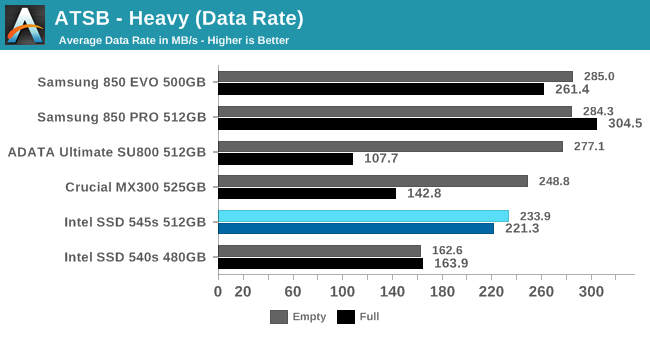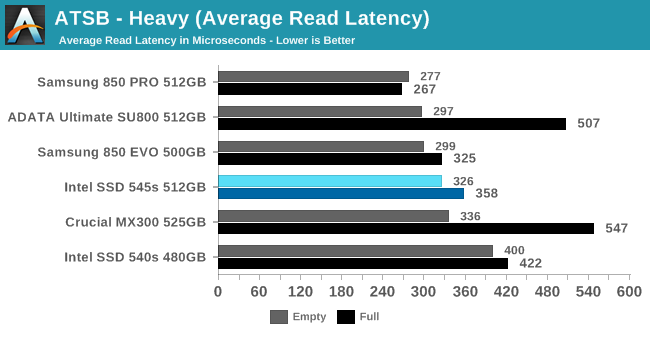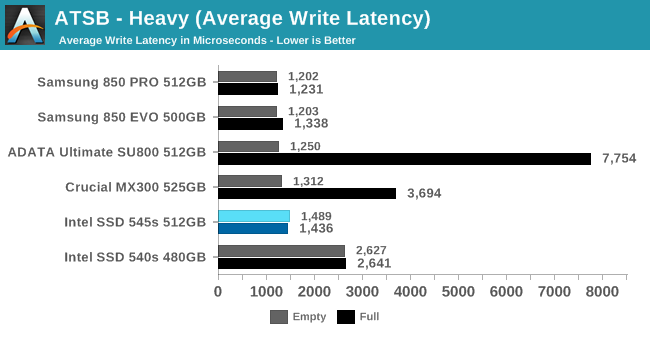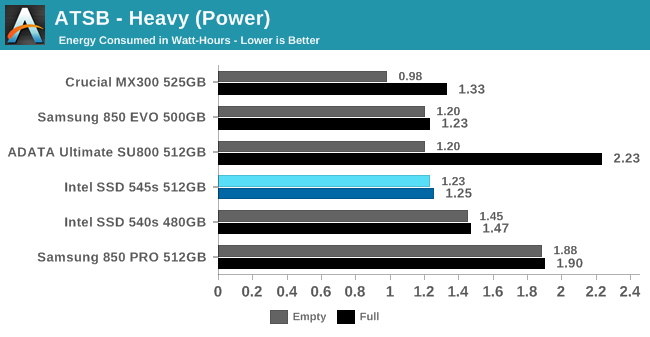The Intel SSD 545s (512GB) Review: 64-Layer 3D TLC NAND Hits Retail
by Billy Tallis on June 27, 2017 6:00 AM ESTAnandTech Storage Bench - Heavy
Our Heavy storage benchmark is proportionally more write-heavy than The Destroyer, but much shorter overall. The total writes in the Heavy test aren't enough to fill the drive, so performance never drops down to steady state. This test is far more representative of a power user's day to day usage, and is heavily influenced by the drive's peak performance. The Heavy workload test details can be found here. This test is run twice, once on a freshly erased drive and once after filling the drive with sequential writes.

The Intel SSD 545s shows substantial improvement over the 540s in average data rates for the Heavy test. The 545s is not quite able to compete against Samsung as was the case for The Destroyer, but it comes much closer than its predecessor.
The 545s also fares far better when the test is run on a full drive than the drives that use the previous generation 32L 3D TLC (ADATA's SU800 and Crucial's MX300). Both of those drives beat the 545s when the test is run on an empty drive, but suffer a huge performance loss when the drive is full.

The latency measurements for the Intel 545s on the Heavy test tell a similar story to the average data rates. Intel is now in the same league as the other 3D NAND SSD, though still in last place. When the test is run on a full drive, the Crucial and ADATA drives fall apart and average latency spikes to the 2–4ms range while the latency of the Intel 545s is unaffected and remains well below 1ms.


The read latency of the older Intel 540s is not too far behind the 3D NAND drives and it handles being full with no trouble, but its write latency in either case is almost twice as high as the 3D NAND drives. The biggest improvement of the Intel 545s comes from cutting that write latency. The read latency also improved enough to surpass the Crucial MX300.

The energy usage of the Intel 545s during the Heavy test has it essentially tied for second place with the Samsung 850 EVO, while the Crucial MX300 has the clear lead when the test is run on an empty drive. The MX300's advantage disappears when the test is run on a full drive and the SU800's energy usage almost doubles.










74 Comments
View All Comments
ddriver - Tuesday, June 27, 2017 - link
Great, now if they could just make a decent NVME SSD as well.ddriver - Tuesday, June 27, 2017 - link
Shame it took them entire 3 years to catch up to the 850 pro. Lets hope they will match the 960 pro before 2020 LOL.eddieobscurant - Tuesday, June 27, 2017 - link
They caught up with the 850 evo, not the proATC9001 - Tuesday, June 27, 2017 - link
True...but atleast for the first time in I think...ever, there's a drive that can compete with the EVO...hopefully we can see the EVO drives start to drop a bit.Alexvrb - Tuesday, June 27, 2017 - link
It IS nice to see some serious competition for the Evo. The 850 Evo is still my go-to for upgrading older systems from a mechanical drive.Now all I need is some serious price drops for lower-performance higher-capacity TLC drives and I can ditch the mechanical drive for mass storage too. Price:capacity hasn't budged much in recent memory. :-/
Impulses - Tuesday, June 27, 2017 - link
Hasn't budged at all... I bought two 1TB EVOs two years ago, almost to the date (Newegg invoice is dated 7/15/2015 for the first one), paid $340 for one and a couple weeks or a month later I managed to get a second one for $320.I was hoping two years later I could buy a 2TB drive to add to those for the same kinda money, instead the prices are exactly the same right now. The recent shortage and price hike didn't help, up until that point I remember prices steadily declining for at least 4-5 years straight...
I guess that couldn't last, historically the flash market has been more volatile (no pun intended) than not, the kind of stability that went on for a couple years aligned with Samsung's rise to SSD dominance were kind of rare in the grand scheme.
At this rate it's gonna be another 3+ years before I can score a couple good 2TB drives for $300/ea, meh.
andychow - Tuesday, June 27, 2017 - link
Nand is in shortage, has been for a few years. In the past, manufacturers would ramp up production, there would eventually be a surplus, and prices would crash. This time around, they've all decided to basically to ride out the shortage by telling their clients to wait.Alexvrb - Wednesday, June 28, 2017 - link
That seems strange. If they have the ability to ramp and fill demand, you would think one of these outfits would be happy to fill that gap and steal those sales. I thought perhaps they are unable to ramp the flash which is in greatest demand. I hope things get better with future heavily-layered TLC/QLC and upgraded controllers. I would like nothing more than to ditch my secondary mechanical drive for flash, but there's no way I'm spending that kind of money.ddriver - Thursday, June 29, 2017 - link
There is nothing strange about it, they know if flash is in shortage they will make more on every grain of sand they put into it. It is like an implicit mutual agreement to sustain an artificial shortage to make more money. And everyone is happy.They still sell as much SSDs as they can, but at a higher price. SSDs are available, but the supply is deliberately held tight, so there is a perpetual "they might run out" even though supply exceeds demand, it is carefully kept short. Nobody is waiting on flash, no company is missing on sales, they still sell as much as they can, they simply take care not to exceed demand by too much, so they do less work to get extra profits. It is an immensely great deal for them.
There is no motivation for any of the big players to end this shortage, because that would drive prices down, hurt their own margins and those of everyone else, and give the others an excuse for hostile actions in retaliation, which they don't really want, because even though to us they are apparent competitors, they are all in it for the money, and they have estimated that cooperating to keep supply tight will win them more than competing who will make the most or the best SSDs.
It sounds like it is illegal, but considering it is all common sense and they didn't have to collude in some dark room to make an explicit agreement to do so, it is perfectly legal as far as the corrupt justice system is concerned.
Error415 - Tuesday, October 3, 2017 - link
Yeah, it should be illegal for a company to decide not drive prices down by flooding the market with cheap products, shm.What sounds illegal to you is a text book example of a sustainable business model. No booms or busts just steady growth and profit.